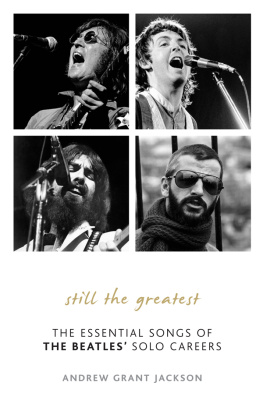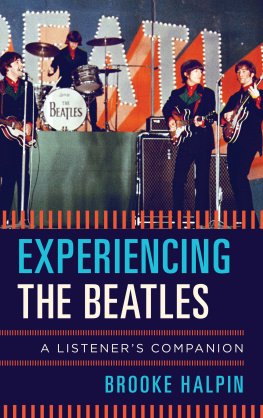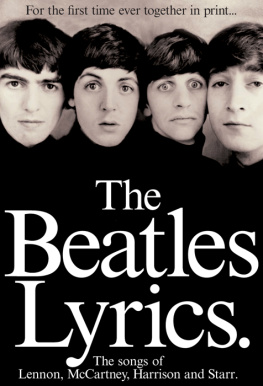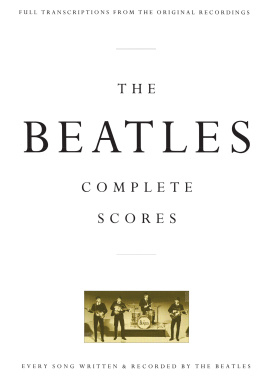
The Beatles Through Headphones
The Quirks, Peccadilloes, Nuances and Sonic Delights of the Greatest Popular Music Ever Recorded
TED MONTGOMERY

McFarland & Company, Inc., Publishers
Jefferson, North Carolina
LIBRARY OF CONGRESS CATALOGUING DATA ARE AVAILABLE
BRITISH LIBRARY CATALOGUING DATA ARE AVAILABLE
e-ISBN: 978-1-4766-1701-5
2014 Ted Montgomery. All rights reserved
No part of this book may be reproduced or transmitted in any form or by any means, electronic or mechanical, including photocopying or recording, or by any information storage and retrieval system, without permission in writing from the publisher.
The Beatles: Ringo, John, George and Paul in the studio, 1967 Apple Corps Ltd./Photofest
McFarland & Company, Inc., Publishers
Box 611, Jefferson, North Carolina 28640
www.mcfarlandpub.com
For my own Fab Four:
Vicki, Kyle, Kelly and Sean
Acknowledgments
No author creates a work of this length in a vacuum. Time and space do not permit me to adequately express my gratitude to the dozens of individuals who supported me while I wrote this book, but several are worthy of particular mention.
Many friends encouraged me, directly and indirectly. Dave Groves patiently listened as I endlessly extolled the drumming virtues of Ringo Starr. Daves a drummer, and that argument doesnt also resonate with every drummer, but Dave was a good sport about it.
Katie Williams conducted vital research for me, and helped to track down the quotes that are scattered throughout the text.
Kevin Knapp, who has written about rock and roll music for several publications, happily engaged me on a variety of Beatles-related topics, and gave me good insights on some of the earliest pages I had written.
Mark Nowlin is a lifelong friend who nurtured my love of the Beatles during our schooldays and beyond. Mark knows as much about the Beatles as anyone I know, and acted as my chief sounding board throughout the writing of this book.
One friend, Al Shippey, is no longer with us, but his impact is felt throughout these pages. Al and I spent 30 years playing and singing Beatles songs together, and much of the musical language I have access to is by dint of my friendship with Al.
Many other lend their support by quietly rooting for the project from the sidelines. Special thanks to Leon Frasson, Debra Lashbrook, Kathleen Wiles, Shelby Olsen, Lillian Lorenzi, Geoff Upward, Mike Dubin, Lois Hunter, Ellen Byerlein, Dan Bodene, Danielle Dimcheff, Mary Micallef, Yvonne Pappas, Jake Alverez and Elena Godin.
My family supported me throughout. Barbara Montgomery, Janis and Carmen Verde, Linda and Brad Harding, Cindy Montgomery, Dan and Patti Montgomery, Lindsay and Jason Harding, Joshua Verde and Elinor, Peter and James Montgomery were all four-square in my corner as I endeavored to create this book.
My wife, Vicki McNiff, and stepkids Kyle, Kelly and Sean McNiff, gave me a wide berth in a small space because they knew how passionate I was about this project. Their love and support was essential to the success of this project. Joey Shada, too.
Finally, it seems rather gauche to write acknowledgements for a book about the Beatles and not give John Lennon, Paul McCartney, George Harrison and Ringo Starr full credit. Their music has played a paramount role in my life, and Im grateful I got to listen in.
Preface
This is a book about the music of the Beatles. It is also a book about listening to their music in a different way.
No other catalogue in popular music is as revered and cherished as the music the Beatles recorded and released between the end of 1962 and the beginning of 1970. Indeed, no other catalogue has influenced more musicians or had such widespread cultural impact as the Beatles. Were still talking about it, parsing and listening to the music more than 50 years after it was created.
Perhaps no other popular cultural icons have had more published works devoted to them than the Beatles. Books about the band number in the hundreds, and include everything from insider looks from producers and engineers, to slightly revisionist hagiographies from those with only peripheral connections to the Beatles inside circle. Fans have written books about their favorite Beatles songs, and disc jockeys and other music industry nabobs have penned fond remembrances based on their own experiences. There are even a few books in circulation that are critical of the band and its music. Such has been the epic sweep of the cultural swath the Beatles cut through the 1960s.
I grew up in a suburban Detroit home with three older sisters firmly in the thrall of the hometown hit-making machine known as Motown Records. The 45s that enjoyed heavy rotation on my sisters record players tended to be the hits that Berry Gordys stable of talent turned out seemingly every other week: the Supremes, the Four Tops, the Temptations. The first rhythm section I heard did not include Paul McCartney and Ringo Starr; it was Benny Benjamin and James Jamerson.
Even though I was very young during the 1960s, I was aware of the constant thrum of pop music that wafted down the hallway. Still, I dont remember hearing the Beatles in our home.
I didnt discover the Beatles until after they had broken up. My best friend and Itotally fascinated by all the colorful gingerbread that graced the covers of Sgt. Pepper and Magical Mystery Tourstarted listening to their records and quickly became infatuated with the sound collages and interesting harmonies the band created. To me, it sounded like no other pop music Id ever heard.
I had a lot of catching up to do. I never got to hear a new Beatles album as it was coming out; their entire output was in millions of homes before I even discovered the band. Over time, I collected the entire catalogue (on vinyl, of course) and my love of Beatles music began to breathe with an energy that seemed exciting and invigorating.
One summer during the mid2000s, I thought it might be interesting to listen to the Beatles entire catalogue on headphones. As this endeavor progressed, I started taking notes on what I heard that I didnt recall hearing over external speakers. The sonic landscape on the headphones was rich with mumbled utterances by the band members, broken guitar solos buried deep in the mix, odd meter mishaps and other delightful ear candy that wasnt obvious if you listened in your car or on your stereo system.
Around this time, I teamed with a professora true Beatles scholarat the university where I worked to lead a weekly Beatles discussion. I was struck by the number of college-age students who came to these discussions; most of them hadnt yet been born on the day John Lennon was murdered.
At this same time, portable digital music players became the main conduit through which we listened to our music. Now, everyone was on headphones (or earbuds). I wondered if anyone else interested in Beatles music was hearing the same things I heard.
Thus, the idea for this book was born.
I spent literally hundreds of hours with headphones strapped to my head, listening and re-listening to everything the group recorded. I was amazed at the things I began to hear that I never really noticed before. At times, it was tedious work; listening to a song like Dont Pass Me By or Maxwells Silver Hammer over and over again demands a certain monkish fealty to the subject at hand. Those moments were tempered by the exquisite and sublime experience of hearing the band rip through the near flawless All My Loving or the heady Youre Going to Lose That Girl.
Next page













![Lambley - And the Band Begins to Play: [Part6 The Definitive Guide to the Beatles Rubber Soul]](/uploads/posts/book/213742/thumbs/lambley-and-the-band-begins-to-play-part6-the.jpg)


